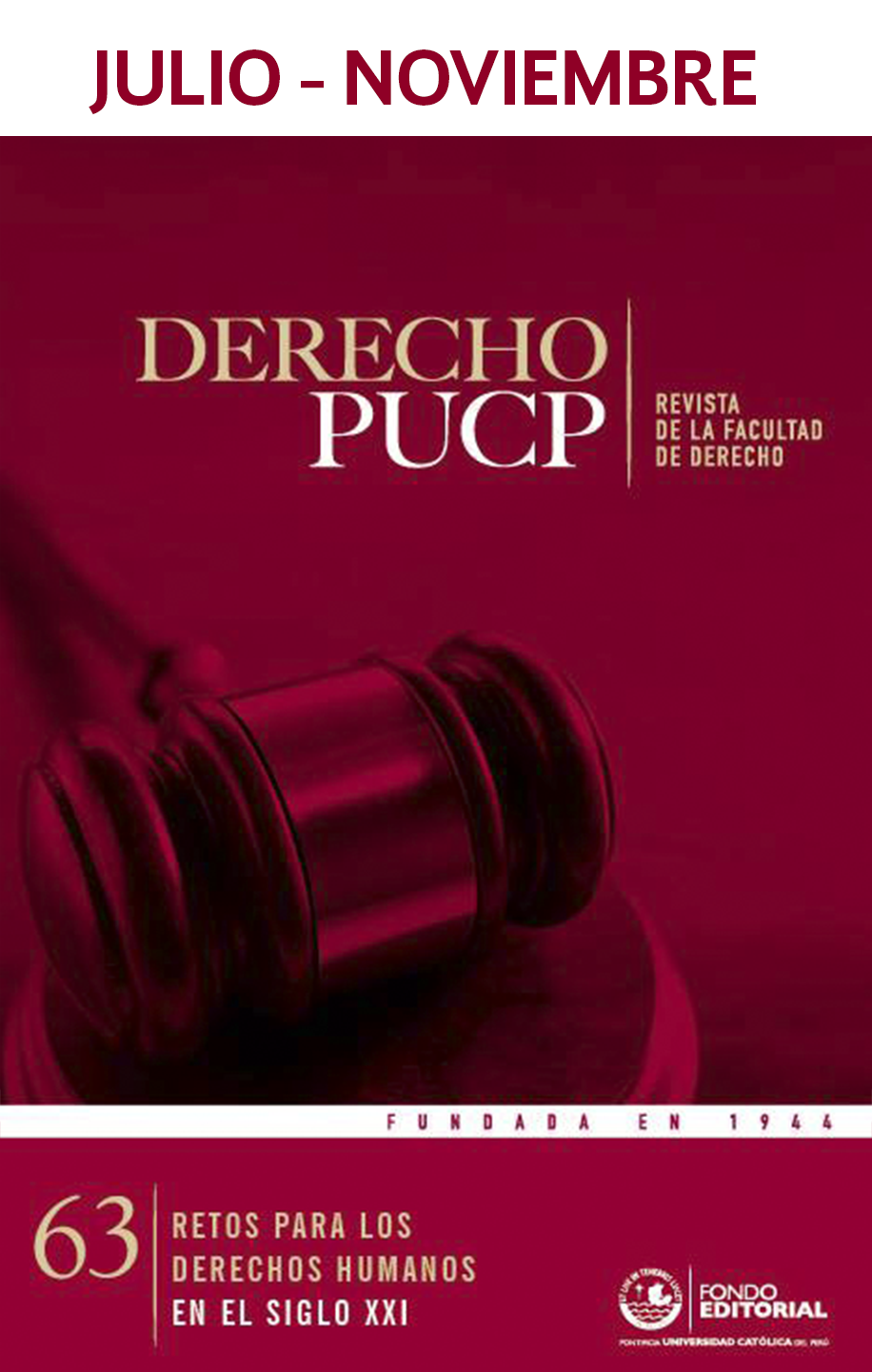Las reformas de 2009 al Reglamento de la Corte Interamericana de Derechos Humanos: una regulación de prácticas existentes y un ajuste del Reglamento de noviembre de 2000
DOI:
https://doi.org/10.18800/derechopucp.200902.007Palabras clave:
Corte Interamericana de Derechos Humanos, Reglamento de noviembre de 2000, Reforma reglamentaria del 2009, Organización de los Estados Americanos, Jurisprudencia de la CorteResumen
En San José de Costa Rica, del 19 al 31 de enero de 2009, la Corte Interamericana de Derechos Humanos realizo su octogésimo segundo período ordinario de sesiones, celebrado en su sede «la Corte Interamericana». Allí se aprobó una serie de reformas puntuales del Reglamento de la Corte Interamericana de Derechos Humanos que entraron en vigencia el 24 de marzo de 2009. En función a ello, el artículo, en primer lugar, plantea los antecedentes y el contexto en el que tuvo lugar la reciente reforma del Reglamento de la Corte. Luego se menciona algunos de sus temas y aspectos más destacados, los cuales tienen que ver, por una parte, con la reglamentación de prácticas que el alto Tribunal interamericano ha venido adoptando en los últimos años y, por otra, con el ajuste de aspectos puntuales del trámite de los casos contenidos en el reglamento adoptado en noviembre de 2000, que entró en vigencia el 1 de junio de 2013. Respecto a ello, el autor hace énfasis en resaltar la evolución de las reglas de procedimiento de la Corte Interamericana en al menos en dos sentidos: por una parte, para hacer más expedito y eficiente el trámite y la resolución de los casos; y, por otra, hacia el fortalecimiento de la capacidad de las personas para actuar autónomamente como verdaderas partes durante los procesos interamericanos. Finalmente, el autor se referirá a los temas pendientes que deben ser abordados en futuras reformas del reglamento de la Corte. Por ejemplo, aún no se da un paso más para conceder a la víctima el ius standi como verdadera parte demandante ante la Corte. En conclusión, la reforma del 29 de enero de 2009, como se ha ilustrado, no contiene grandes cambios o modificaciones radicales que impliquen una alteración sustancial de las etapas procesales o de las facultades procesales esenciales de las víctimas, los Estados y la Corte IDH; se trata, por un lado, de darle consagración reglamentaria a prácticas ya existentes, que habían sido bien recibidas por las partes; y, por otro lado, de hacer ajustes puntuales a ciertos aspectos de las reformas de 2000 y de 2003 que habían demostrado afectar el equilibrio procesal o la agilidad del trámite, bien por ser innecesarios o por no favorecer la celeridad procesal.
Descargas
Citas
Cançado, Antonio (2003). El nuevo reglamento de la Corte Interamericana de Derechos Humanos y su proyección hacia el futuro: la emancipación del ser humano como sujeto del Derecho internacional.
Corte IDH. (2009). Segunda Etapa de Reformas al Reglamento de la Corte Interamericana de Derechos Humanos.
Corte IDH. (27 de enero de 2009). Resolución de la Corte Interamericana de Derechos Humanos.
Corte IDH 2009). Exposición de Motivos de la Reforma Reglamentaria.
Corte IDH (4 de noviembre de 2000). Reglamento de la Corte Interamericana de Derechos Humanos.
Corte IDH y Alto Comisionado de Naciones Unidas para los Refugiados. (2003). El futuro de la Corte Interamericana de Derechos Humanos (pp.11-108). En AG/RES. 2030 (XXXIV-O/04).
Corte IDH. (1979). Estatuto de la Corte Interamericana de Derechos Humanos.
Garrido y Baigorria c. Argentina [sentencia de reparaciones, costas], Serie C, número 39. (Corte Interamericana de Derechos Humanos, 19 de junio de 1998).
Masacre de Las Dos Erres c. Guatemala [ sentencia de excepciones preliminares, fondo, reparaciones y costas]. (Corte Interamericana de Derechos Humanos, 24 de noviembre de 2009).
Niños de la Calle c. Guatemala [sentencia de fondo], serie C, número 63. (Corte Interamericana de Derechos Humanos, 19 de noviembre de 1999).
Observaciones y Recomendaciones al Informe Anual de La Comisión Interamericana De Derechos Humanos. (3 de Junio De 2008). Ag/Res. 2409 (Xxxviii-O/08).
OEA. (3 De Junio De 2008). Fortalecimiento de los Sistemas De Derechos Humanos en Seguimiento de los Mandatos Derivados De Las Cumbres De Las Américas. En AG/RES. 2407 (XXXVIII-O/08).
Paniagua Morales c. Guatemala [sentencia de fondo], serie C, número 37. (Corte Interamericana de Derechos Humanos, 8 de marzo de 1998).
Radilla Pacheco c. México [sentencia de excepciones preliminares, fondo, reparaciones y costas]. (Corte Interamericana de Derechos Humanos, 29 de mayo de 2009).
Valle Jaramillo y otros v. Colombia [sentencia de fondo, reparaciones y costas] serie C, N° 192. (Corte Interamericana de Derechos Humanos, 27 de noviembre de 2008).
Descargas
Publicado
Cómo citar
Número
Sección
Licencia
Derechos de autor 2016 Derecho PUCP

Esta obra está bajo una licencia internacional Creative Commons Atribución 4.0.




